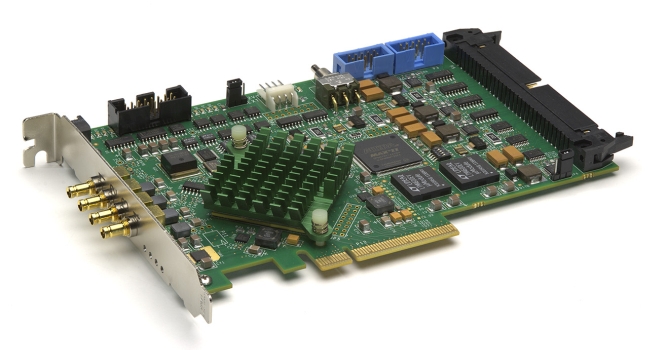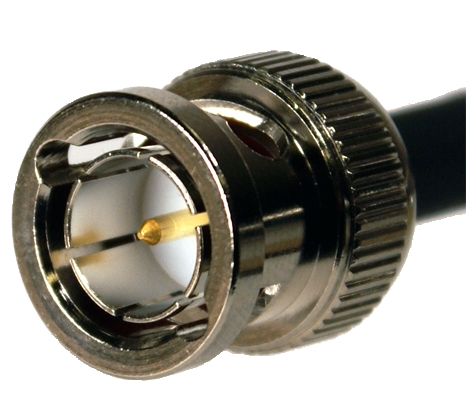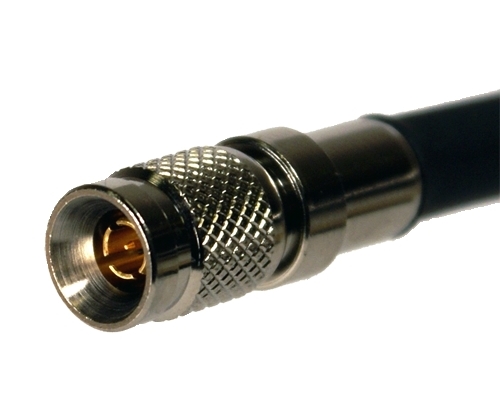Michael Correia
- What is CoaXPress?
- Frame Grabbers
- Data Rate Calculations
- External Frame Grabbers
- Distances
- Connectors
What is CoaXPress?
CoaXPress is the fastest widely-adopted machine vision interface. Like SDI, it uses coaxial cable to trasmit digital data at great speed over long distances. When it was first released in late 2010, CoaXPress was capable of transmitting power (PoCXP), triggers, and data at 6.25 Gigabits per second over a single cable. Eight years later, the second iteration of CoaXPress was released, doubling the bandwidth to 12.5 Gbps. What makes CoaXPress the fastest interface is the use of multiple cables per camera. Cameras often use 4 cables at a time, offering a max speed of 25 Gbps in the first version, and 50 Gbps in the second version, truly unbeatable by any widely adopted machine vision interface. You can browse our available CoaXPress cameras here.
Frame Grabbers
 A PCIe x8 Gen 2 CoaXPress frame grabber, supporting 4 CXP-6 connections
A PCIe x8 Gen 2 CoaXPress frame grabber, supporting 4 CXP-6 connections
While CoaXPress does have an advantage in speed, it does not build off of an existing standard, like GigE Vision and USB3 Vision. Because of this, CoaXPress requires a frame grabber. Frame grabbers are PCIe cards which send the camera information into the computer's RAM.
Due to CoaXPress's high speed, it's important to make sure you select the right frame grabber, as the PCIe bus also has speed limitations. There are two things to pay attention to: the number of lanes, and PCIe generation.
The number of lanes dictates the number of connections the PC has to the frame grabber. An eight lane board might not work in a four lane port. The number of lanes may also dictate the size of the board.
The generation will determine how fast each lane operates. Most frame grabbers today will either be Generation 2 or 3. Generations are backwards compatible; using a PCIe Gen 3 board with a PCIe Gen 2 socket or PCIe 2 board with a PCIe Gen 3 socket will run at PCIe Gen 2 speeds. The below chart will allow you to see the lane speeds per generation.
Approximate Effective Data Rate for PCIe lanes per Generation
| Generation Number |
Data Rate per Channel (Gigabits per second) |
Data Rate for 4 Channels (Gigabits per second) |
Data Rate for 8 Channels (Gigabits per second) |
| 1.0 |
2 |
8 |
16 |
| 2.0 |
4 |
16 |
32 |
| 3.0 |
7.877 |
31.5 |
63 |
| 4.0 |
15.75 |
63 |
126 |
| 5.0 |
31.5 |
126 |
252 |
Data Rate Calculations
To calculate the data rate your application will use, apply the following equation: Number of Horizontal Pixels × Number of Vertical Pixels × Bit Depth (usually 8) × Frame Rate = bits per second. To convert to Gigabits per second, divide by 10 9.
For most applications the default bit depth of 8 is acceptable. When using 10, 12, or 14 bits, extra consideration must be taken. Data in a computer is represented in bytes, which is a collection of 8 bits. When using a bit-depth which is a multiple of 8, pixels will take up entire bytes (16-bit pixels take up 2 bytes). Things may get a little bit complicated when dealing with 10, 12, and 14 bits.
CoaXPress link protocol mandates the transmission of pixel information in a packed format; this means that a byte may contain data from 2 pixels. For example, a 12-bit monochrome image would have the first byte represent 8 bits of the first pixel, and the second byte's first four bits would finish off pixel 1. Then, the first four bits of pixel 2 would be placed in the remaining four bits of byte 2, and byte 3 would finish off the remaining 8 bits of pixel 2. Thus, 2 pixels can be represented by 3 bytes. In an unpacked system, each pixel would take up 2 bytes, where part of a byte is unused. While the frame grabber may receive data in a packed format, it might not send the data over the PCIe interface in a packed format. You should consult with your frame grabber manufacturer to determine how data will be sent over the PCIe interface. You could also just assume the worst case (unpacked) when determining your data rate. To do this, round your bit-depth up to the nearest multiple of 8.
Finally, if using a 3CMOS camera or 3CCD camera, or using a camera that performs demosaicing inside the camera, remember to multiply the bit depth by 3. You will need slightly more bandwidth than your image data rate, as this does not factor in any Gen<i>cam information like control signals, and the start/end of a frame.
External Frame Grabbers
The Thunderbolt Interface offers PCIe connectivity, allowing laptops and smaller computers to connect to frame grabbers outside the host machine. Thunderbolt 2 supports PCIe x4 Gen 2 (4 lanes, Generation 2), while Thunderbolt 3 offers PCIe x4 Gen 3. The amount of devices which support Thunderbolt has been limited, and outside of fiber-optic Thunderbolt 2 cables, cables are typically only a couple meters at most. With the announcement of USB 4 and its possible inclusion of Thunderbolt 3, this may change.
Distances
CoaXPress is capable of transmitting data over moderate distances using coaxial cables. It can support the following speeds:
CoaXPress transmission distances per coaxial cable
| Data Rate |
Maximum Distance |
| 1.25 Gbps (CXP-1) |
105 meters |
| 3.75 Gbps (CXP-3) |
85 meters |
| 6.25 Gbps (CXP-6) |
35 meters |
| 12.5 Gbps (CXP-12) |
25 meters |
If these distances are insufficient, users could try thicker cables, which may achieve longer distances. Additionally, CoaXPress has the ability to be repeated over coaxial cables, or even separate the protocol from the copper cables, and transmit over fiber optics instead. There have been discussion about merging the CXP standard with Camera Link HS, to offer the best of both worlds.
Connectors
 BNC is physically larger, but more secure than a DIN 1.0/2.3 connector
BNC is physically larger, but more secure than a DIN 1.0/2.3 connector
CoaXPress typically uses the popular DIN 1.0/2.3 and 75 Ω BNC connectors, although it is possible to use other connectors, such as micro-BNC (HD-BNC). These connectors do not affect the 75 Ω characteristic impedance cable, so it is possible for a cable to be DIN 1.0/2.3 on one side and 75 Ω BNC on the other. DIN 1.0/2.3 connectors can be either screwed into the port, or use a push-pull connector, which can be convenient. For more rugged applications, these should be avoided in favor of BNC or even micro-BNC
 DIN 1.0/2.3 connectors come in both push-pull (pictured) and screw-in forms
DIN 1.0/2.3 connectors come in both push-pull (pictured) and screw-in forms